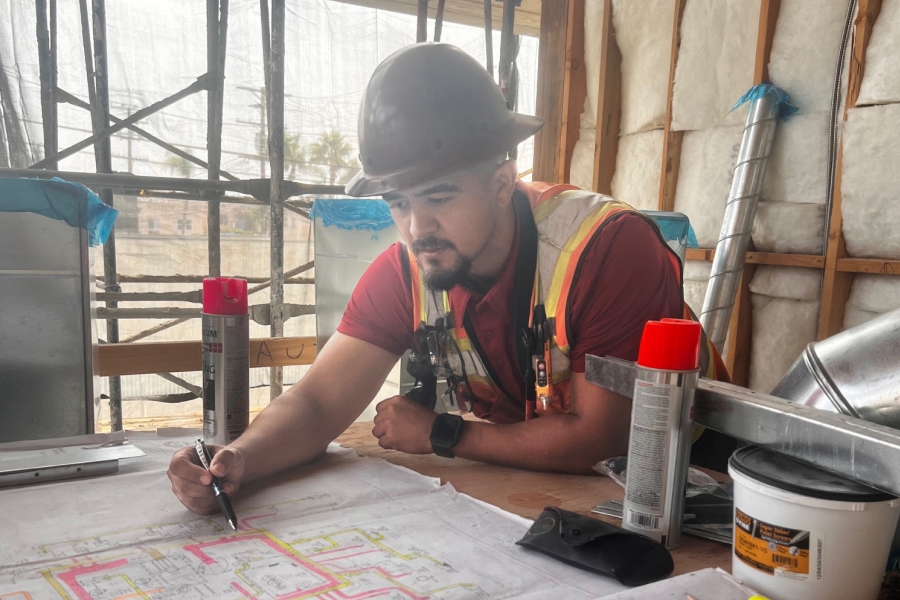The skills gap in construction trades continues to grow. With traditional, four-year university enrollment declining, is there an opportunity for the skilled trades to make up some ground?
Reporting from the National Student Clearinghouse Research Center for Spring 2023 shows that “following two straight years of steep pandemic-related declines” in enrollment across all secondary education institutions, enrollment in four-year institutions “continued to decline … although at a slower pace than last year.”
In contrast, spring 2023 enrollment in undergraduate certificate programs increased 5.5%, and associate degree programs are starting to see growth, with an increase of 0.3%. Some of the strongest growth in undergraduate certificate program enrollment comes from mechanic and repair technologies, the report shows.
However, freshman enrollment in four-year institutions has begun to grow again, and those young people who decide not to become students at colleges and universities aren’t necessarily running toward the construction trades as an alternative. In other words, the construction industry still has hard work to do if it hopes to attract young people to close the age and skills gaps in the skilled trades.
Why young people aren’t joining the construction trades
The reasons why people are looking for alternatives to four-year programs aren’t mysterious. Post-education costs have risen at a faster pace than inflation. Many students, meanwhile, leave with significant student debt and mediocre job prospects.
Also, attending college after high school has become less attractive to young people more interested in finding good-paying jobs without the costly investment of higher education. Unfortunately, skilled construction trades haven’t attracted enough of this group to make a dent in the skills gap or replace workers aging out. Industry trade group Associated Builders and Contractors (ABC) reports that the “construction industry will need to attract an estimated 546,000 additional workers on top of the normal pace of hiring in 2023 to meet the demand for labor.”
Some students are never going to be interested in the physically demanding work of construction. Yet decades of parents, teachers and high school guidance counselors pushing students toward four-year degrees included the pushing of negative views of working in the trades as dirty, manual labor that’s not fulfilling or well-paid.
RELATED:
Many young people have accepted construction’s branding as low status work. Cyndie Williams is a journeyman carpenter and executive director of the Carpenter Contractor Trust (CCT), an organization that markets and promotes signatory contractors and union carpenters with the goal of expanding their employment opportunities.
Part of Williams’ work is promoting skilled construction trades to young people. She sees “the societal pressure to have the college experience. High school students nearing graduation are often told that the path toward success goes through a college degree. This perception takes the spotlight away from numerous other careers that may be a better fit for many students. Most of these students simply learn enough other options.”
The skilled trades need better marketing
The opportunities for construction trades to improve their reputation to younger generations exist as many of the qualities of skilled trades align with their values. They value financial security, so being able to earn money as they train for the job through an apprenticeship program rather than take on student debt can be a strong motivator.
Chris Jordan has worked as a welder for nine years. He also opened a house painting business when he was 22 years old. “I didn’t get a bachelor’s degree and I don’t regret it at all,” he said. “I think students should know that you can earn a lot of money after going to trade school and doing something you really enjoy.”
Another aspect the construction trades can emphasize: the high degree of personal satisfaction many find in becoming a skilled craftsperson.
Reflecting on her career and work with CCT promoting carpentry as a profession, Williams said, “There are people who enjoy working out in the open. They can bind mentally and physically challenging work and lifestyle where they create something with their hands. They’re able to say, even decades later, ‘Hey, I built that.’ There’s a huge sense of personal accomplishment in the trades and a very nice paycheck to match.”
Addressing the stigma and assumptions about skilled trade work is only part of the picture. Even students who may be or would be interested may not know where to get started. There are also concerns on starting a career in physically demanding fields. Better marketing of skilled construction work requires increasing awareness of how to get into the trades along with identifying the long-term career possibilities.
Promote more pathways to the trades
Unless the student has family members working in the trades, it’s likely that they don’t know where to start. With most parents and high school counselors still working with bias toward pushing students to four-year degree programs, many students aren’t getting guidance from there, either. Union-sponsored apprenticeships, trade associations and community college and certificate programs all exist, but they aren’t necessarily well-known to high school students.
Shining a light on the many paths to a skilled trade profession is a large part of Williams’ work, both as executive director of CCT and former chair of Sisters in the Brotherhood, a group within the United Brotherhood of Carpenters and Joiners of America (UBC) dedicated to supporting women in carpentry.
One CCT program she highlights is the Career Connections program. Williams said it’s “a curriculum that was developed by the carpenters union and is in high schools across the country. It helps students develop real-world construction skills and puts them on a path toward a rewarding career in a high-demand field.”
The credits high schools students earn through the Career Connections program are also accepted as college credit in some cases, shortening the time and cost for those who want to earn certificates or associate degrees in a construction trade. According to Williams, “high school students often think that vocational or trade school training isn’t as comprehensive as college. However, the fact that it’s a hands-on and practical approach to learning, it’s a very cost-effective way to start their careers early, while also being able to apply these hours toward an associate’s or bachelor’s degree in related fields like construction management.”
Companies are running their own programs to help steer more people into the trades. In 2018, home improvement retailer Lowe’s launched “Track to the Trades,” a pre-apprenticeship program to help its employees get into a skilled trade. The company is also reaching out to improve opportunities for non-employees, too. In March, the Lowe’s Foundation “announced a $50 million commitment over the next five years to prepare 50,000 people for skilled trades careers through grants to community and technical colleges and community-based nonprofits.”
Skilled tradespeople have a variety of long-term career options
The physical demands and dangers of the work is a legitimate concern as young people try to envision how their long-term career in construction might progress. Attracting the next generation of skilled tradespeople requires highlighting the different ways their careers can progress, not just the entry path.
Chad Montgomery was an apprentice electrician who felt the physical toll construction work has on the body. “I was only in the field for a year and a half, and I had constantly cut-up hands and a sore body,” Montgomery said. He used his experience from construction to get an accelerated diploma in architectural and building technology. Montgomery now works as an estimator and project coordinator with a construction company.
Looking at his career trajectory, he said, “There’s no right or wrong answer about the better career path, but there are opportunities high school students aren’t considering when making their decision. Not everybody is wired to sit in front of a computer screen all day.”
A unique opportunity in time
With high student debt and declining earnings for graduates of four-year degrees, young people are looking for new alternatives. The construction skilled trades gap is growing, yet more can be done to attract young people. Technology may help ease the workforce squeeze a bit, but won’t fill the gap on its own.
Even so, Williams feels “optimistic that the more we connect to communities, we can deliver the message that the trades aren’t just offering jobs, but rather lifelong careers. As a skilled tradesperson and as an industry, we really need to show people what trades can offer them and their communities.”












